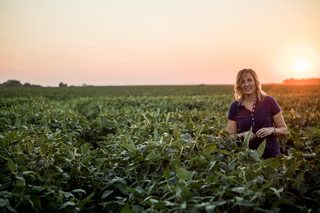Millennials are coming back to their family farms and arming themselves with new ways of communicating with their customers.
Communication is an important component to any successful business and the relationship America’s farmers and ranchers have with the consumers of the products they produce is no different. The agricultural landscape is made up of many different types of production, each vying to gain a larger market share through consumer marketing, and it is becoming increasingly more difficult for consumers to sort through the information that inundates their inboxes and social media feeds every second of every day. What is even harder is the task of farmers and ranchers to reach consumers with factual information.
In a 2014 study by BASF, 2,100 farmers and 7,000 consumers, in seven countries, were surveyed through a series of the same questions to determine their perception of agriculture. Over 90 percent of both farmers and consumers saw farmers as providers of food and a critical component of food security. However, farmers also saw themselves as stewards of the land, not only providing the food for a growing population; farmers surveyed were concerned with land use, soil protection, water use, fair farm wages and biodiversity protection and enhancement.
This ongoing division between the agricultural producer and consumer has shaped perception of the industry, as a whole, and is influencing policy at the local, state and national level.
The key to bridging the consumer perception gap: communication.
Millennial Communication
Today nearly everyone has a smartphone, and on those smartphones is a menagerie of applications, each serving a different purpose, collecting data and influencing the communication climate of its user base. Pair this data overload with the impact of a world of social media that has allowed its users to be connected every moment of every day, and the net output is a generation of real-time communicators.
Real-time communication and the hot-button conversations populating communication devices are changing conversations in agriculture.
Today’s farmers are writing blogs, sharing photos of everyday life on Instagram, producing their own farm videos via Facebook Live and welcoming the public on their farms through live video tours. This outreach is creating a level transparency the industry has never seen before, and the value isn’t going unnoticed.
As a motivational speaker and business consultant, Bryan Dodge of Dodge Development, Inc., works with small businesses, including family farms, across the country. He agrees that communication within the agriculture industry is changing and is optimistic for the future outcome of those tough conversations surrounding agriculture production practices. Dodge believes that unification and communication are going to be the key components in breaking the barriers of public perception.
“Farmers will need to unify in order to change public perception. They are going to have to be students, and continue being students to learn and adapt to the changes that continue within the industry,” he says.
These “student” farmers, Dodge says, can be found in the millennial generation returning to the farm and the experiences and technologies that have helped them to remain in a perpetual learning mindset.
“There are 100 times more students coming up in the millennial generation than previous generations returning to the farm. Why? Because (millennials) left the farm. You can’t ever change your mindset unless you leave the farm and gain new experiences,” says Dodge.
Leaving the farm, or at least gaining experiences additional to life on the farm, is one of the factors changing the approach the millennial generation is taking in their communication strategies for advocacy and business management.
“This generation (millennial) is going to accelerate the middle as the older generation retires,” says Dodge.
Coming Home
Melissa Hildebrand Reed’s story represents much of what the industry is seeing with the millennial generation returning to the farm and the asset their integration can provide to an operation.
An on-farm bottling operation started in 2008, Hildebrand Dairy is a family operation in every sense of the word. A 150-cow Holstein herd provides the milk for the 5,000 gallons the family bottles and ships to locations throughout the state of Kansas each week. Today’s Hildebrand family enterprise, consisting of two brothers and their children, got its start in 1910 when Hildebrand Reed’s great-grandparents first bottled the milk their four dairy cows produced and sold it door to door to their neighbors within the community.
Today, hard work and dedication are still an important aspect of day-to-day life on the Hildebrand Dairy farm.
Hildebrand Reed’s day begins at 6 a.m. on the farm, as she gets the bottling facility operations underway and monitors the pasteurization of the day’s bottling milk. From the bottling facility, she heads to her office where she spends the remainder of her day scheduling orders, answering customer emails, monitoring inventory, managing human relations and managing the company’s marketing endeavors.
This busy farm life wasn’t always the path she envisioned for herself, however.
“Growing up on the farm, I appreciated the life I had, but it wasn’t until I really took a step back (from the farm) in college and then living in Austin, Texas that that appreciation really magnified. I lived in Texas for three years and as soon as I started thinking more about settling down, marrying my then boyfriend, and starting a family, my perspective changed. I knew that the farm was the absolute best place to raise a family. I wanted to come back before I had kids, knowing that was what I wanted for their future. Coming home was a gift to my kids.”
And taking time away from the farm to pursue other career opportunities gave Hildebrand Reed more than an appreciation for life on the farm; it opened her eyes to opportunities the operation could capitalize on.
While in Texas, Hildebrand Reed worked with several small businesses to create marketing and branding strategies and campaigns. Coming home, she knew that she had more than labor to offer her family’s business, but also knew that getting an older generation on board for those expenditures would be tough.
Hildebrand Reed says that she didn’t start off asking for a marketing and communications budget because she knew that they would most likely be vetoed before she could show the value they would provide the business.
“I love the farm, but we run it like a business, because it is. I added another component of that business, one that really hadn’t been identified as not being there until I presented it. I slowly introduced the idea of branding and marketing and how we could be more effective in our outreach. It was a really slow process, I started small with things like business cards and began to grow to larger campaigns.”
Today, Hildebrand Reed handles all of Hildebrand Dairy’s communications and marketing strategy and focuses on helping to grow the reputation of Hildebrand Dairy as both a great place to work and a brand consumers can feel comfortable purchasing from.
The outreach and communication doesn’t stop there, though. Hildebrand Reed is also a volunteer member of CommonGround Kansas, a national grassroots organization that connects farm women to consumers across the country.
“When I first came back to the farm, one of the things that was quickly and excitedly handed over to me was consumer relations. When we created our own product, we knew that we would have the opportunity to talk directly to our customer base. I’m not sure that my parents anticipated the loud voice of that minority that we opened ourselves up to,” says Hildebrand Reed. “I have always felt comfortable talking with our customers, but CommonGround helped hone those skills, especially in tough conversations.”
Creating Advocates
Statistics compiled by the American Farm Bureau Federation find that the millennial generation, those aged 34 years and under, include roughly 257,454 farmers. These farmers, collectively, are the greatest communicators the industry has ever had in terms of transparency and connectedness and are helping to provide the public relations for the 2.1 million farms across the United States.
This isn’t news to the dozens of organizations committed to helping millennial farmers find their voice in sharing the stories that matter to the family farm.
Missy Morgan, Manager of the national CommonGround program, a collective effort of the United Soybean Board and National Corn Growers Association, says that the growth and outreach the program has seen in a few short years has been nothing short of amazing.
“Across organizations, men and women on the farm are recognizing that their voice does matter. When CommonGround launched in 2011, it was in five states with a combined 14 volunteers. Today we are active in 21 states and have over 200 volunteer members,” she shares.
Morgan observes that every farmer who participates shares a common goal: to create a more informed consumer, a consumer who makes choices based on facts, not fear.
“After joining the organization, each volunteer completes a profile questionnaire,” says Morgan, “Every questionnaire encompasses the same volunteer response to some extent. And that resonating message is: ‚ÄòI’m passionate about how food is raised and I really want to help consumers understand how their food is grown.'”
The organization provides state-wide trainings and a national conference each year for its members, helping them to build a network of both camaraderie in communication and support in the tough questions and accusations that farmers today find themselves facing.
State commodity association efforts are also embracing a new era of communication and the millennial farmers who are tasked with delivering those messages.
“From an overall agriculture association standpoint, we are changing the ways we communicate with farmers today; we are stepping back and taking a look at what we are communicating and how we are delivering those messages to ensure that we are talking to them where they are and that we are being efficient with our information.” says Stacy Mayo-Martinez, who serves as Director of Industry Relations for the Kansas Corn Growers Association (KCGA).
Like other organizations working to communicate and connect farmers and consumers, KCGA recognizes the constant connectedness farmers have at their fingertips. They have worked to develop training and programming that helps farmers to leverage that connectedness through social media and effective messaging training when it comes to having those tough consumer oriented conversations about practices on their farms.
Mayo-Martinez notes that the channel of communication has shortened with social media and instant access to email and messenger services.
“Farmers have the ability to talk to other farmers, industry representatives, consumers, and elected officials, through online and social networks without ever having to leave the cab of the tractor.”
KCGA, like many state commodities, creates programming with an industry goal of creating industry awareness, leadership and advocacy. During 2018, KCGA will offer three core programs: Corn Corps, Careers in Corn and Collegiate Academy to help students and young industry members identify obstacles facing the industry and equip them with the tools they need to respond to those challenges.
“There are a lot of people considering agriculture as a career and we have a great opportunity to create advocates for the industry through those students and young professionals, even if they don’t return to the farm,” says Mayo-Martinez, referencing the communication components of the programming.
Each program will focus on a specific demographic within the industry in hopes of helping participants better connect to the resources and information available to them, as well as the consumer.
The Kansas Corn Collegiate Academy will aid students who want to learn more about the corn industry: the careers and opportunities it offers, as well as enhance their professional development. The inaugural class will participate in three learning sessions, a day at the Capitol in Topeka, and a week-long learning experience with Corn Congress in Washington, D.C.
“Each student will have the opportunity to network within the industry and gain a better understanding through tours and a capstone project that they will complete,” says Mayo-Martinez. “They’re going to be able to learn more about trade, ethanol, livestock, policy, conservation and education, and consumer trends.”
Corn Corps focuses on the older demographic of the millennial spectrum, helping farm couples and individuals alike navigate consumer relations, farm identity and branding, and the strategic communications that can help their farms achieve marketing goals.
The third initiative, the Careers in Corn program, helps students identify off-farm experiences and opportunities in the corn industry through a network of talks by industry professionals throughout Kansas’ network of colleges and four-year institutions.
Evolution of Communication
Across the industry, professionals agree that the impact millennial communication has had on agriculture is positive.
“CommonGround would have never gotten off the ground without the incredible volunteer base we have. It really took farms realizing that they do have a voice and what they say matters,” shares Morgan.
The conversation around agriculture continues to evolve as future generations return to the farm with their sights set on the implementation of new strategy and development. The fresh ideas and skillsets millennials are bringing back to the farm are changing the industry from within. And it is clear that while their passion and dedication for the agriculture industry is as strong as the generations preceding them, their method of delivery and presentation is a new and exciting course for the industry.












